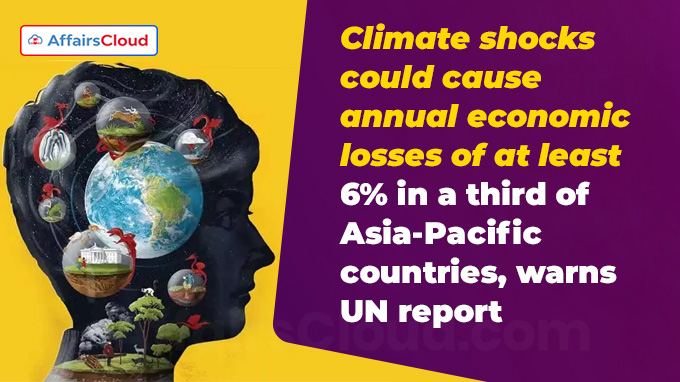 On April 8, 2025, the United Nations Economic and Social Commission for Asia and the Pacific (UNESCAP) released the “Economic and Social Survey of Asia and the Pacific 2025: Understanding the Macroeconomic Implications of Climate Change,” emphasizing the profound economic challenges the Asia-Pacific region faces due to climate change.
On April 8, 2025, the United Nations Economic and Social Commission for Asia and the Pacific (UNESCAP) released the “Economic and Social Survey of Asia and the Pacific 2025: Understanding the Macroeconomic Implications of Climate Change,” emphasizing the profound economic challenges the Asia-Pacific region faces due to climate change.
- The UN warns that climate disasters could cause annual economic losses of at least 6% of the Gross Domestic Product (GDP) in one-third of Asia-Pacific countries.
- Despite contributing 60% to global economic growth in 2024, many countries in Asia-Pacific region are inadequately prepared for climate-induced shocks and the transition to greener economies.
Key Findings:
The report identifies slower productivity growth, high public debt risks, and rising trade tensions as key threats to regional resilience. It emphasizes the macroeconomic-climate interplay, urging governments to balance growth with sustainability.
Countries Most Vulnerable to Climate Risks:
i.The survey analyzed 30 Asia-Pacific countries, identifying 11 as particularly vulnerable to climate risks from a macroeconomic perspective are Afghanistan, Cambodia, the Islamic Republic of Iran, Kazakhstan, the Lao People’s Democratic Republic, Mongolia, Myanmar, Nepal, Tajikistan, Uzbekistan and Viet Nam.
- These nations face heightened risks due to dependence on climate-sensitive sectors like agriculture, fossil fuels, and coastal economies.
Economic Growth Projections for India and Asia-Pacific Region
1.India’s Outlook:
i.Real GDP growth is forecast to rise to 6.5% in 2025 (up from 6.2% in 2024), with inflation easing to 4.3%.
ii.By 2026, GDP growth is projected to reach 6.6%, supported by sound macroeconomic fundamentals, while inflation is expected to drop further to 4%.
2.Asia-Pacific Region:
i.The Asia-Pacific region’s average GDP growth slowed to 4.8% in 2024 from 5.2% in 2023 and 5.5% pre-pandemic (2015–2019).Average economic growth in the developing Asia-Pacific region is projected to moderate slightly further to 4.5% in 2025 and 4.4% in 2026.
- Average inflation eased to 5% in 2024 from 5.4% in 2023 amid lower global commodity prices and tight monetary policy stance earlier.
ii.Least Developed Countries (LDCs) grew at 3.7% in 2024, far below the 7% annual target under Sustainable Development Goal (SDG) 8 (Decent Work and Economic Growth).
iii.The report categorizes India, along with China, Georgia, Indonesia, Republic of Korea, and the Philippines, as countries with low climate risk exposure and high coping capacity due to strong institutional governance, resilient infrastructure, and enhanced financial systems
Average Annual Loss:
For the 30 Asia-Pacific countries assessed, the Average Annual Loss (AAL) due to climate-related disasters is estimated at 4.8% of Gross Domestic Product (GDP).
- Cambodia faces the highest vulnerability, with an AAL of nearly 11% of its GDP, primarily due to floods and droughts
- Fiji, Myanmar, and Pakistan each experience annual economic losses exceeding 7% of GDP, largely intensified by fragile infrastructure.
About United Nations Economic and Social Commission for Asia and the Pacific (UNESCAP):
Executive Secretary – Armida Salsiah Alisjahbana (Indonesia)
Headquarters – Bangkok, Thailand
Established – 1947




